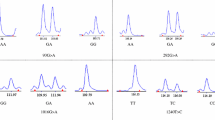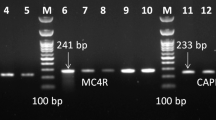Abstract
Mutations of the melanocortin-4 receptor (MC4R) gene are associated with the appetite, obesity and growth in pig, mice and human. But little is known about the function of chicken MC4R gene. In this study, F2 chicken resource population derived from broilers crossing to Silky was screened for the polymorphisms of the MC4R gene using PCR-single strand conformation polymorphism (PCR-SSCP) and DNA sequencing methods. Four single nucleotide polymorphisms (SNPs) sites were found. The mutation (C→T) in the 5′ regulation region of chicken MC4R gene results in one more NF-E2 and cap transcription factor binding sites in the mutation allele than in the wild allele. One missense mutation (G→A) occurs in the coding region (61nt), which changes the glycine to arginine. Moreover, in the coding region there are 2 synonymous mutations, one G→T mutation at 315nt and one C→T mutation at 336nt. Least square analysis of the SNPs and carcass traits showed that BB, DD and FF genotypes are significantly associated with body weight, carcass weight (or half carcass weight), and leg muscle weight (P<0.05 or P<0.01). But no significant association between the genotypes and abdominal fat weight is found. The results present the evidence that the chicken MC4R gene can be selected as the major candidate gene for the carcass traits such as body weight and growth.
Similar content being viewed by others
References
Yeo G S, Farooqi I S, Challis B G, et al. The role of melanocortin signalling in the control of body weight: Evidence from human and murine genetic models. QJM, 2000, 93(1): 7–14
Andersson L. Melanocortin receptor variants with phenotypic effects in horse, pig, and chicken. Ann N Y Acad Sci, 2003, 994: 313–318
Xu B, Goulding E H, Zang K, et al. Brain-derived neurotrophic factor regulates energy balance downstream of melanocortin-4 receptor. Nat Neurosci, 2003, 6(7): 736–742
Sinha P S, Schioth H B, Tatro J B. Roles of the melanocortin-4 receptor in antipyretic and hyperthermic actions of centrally administered alpha-MSH. Brain Res, 2004, 1001(1–2): 150–158
Hoggard N, Hunter L, Duncan J S, et al. Regulation of adipose tissue leptin secretion by alpha-melanocyte-stimulating hormone and agouti-related protein: Further evidence of an interaction between leptin and the melanocortin signalling system. J Mol Endocrinol, 2004, 32(1): 145–153
Costa J L, Brennen M B, Hochgeschwender U. The human genetics of eating disorders lessons from the leptin/melanocortin system. Child Adolesc Psychiatr Clin N Am, 2002, 11(2): 387–397
Dubern B, Clement K, Pelloux V, et al. Mutational analysis of melanocortin-4 receptor, agouti-related protein, and alpha-melanocyte-stimulating hormone genes in severely obese children. J Pediatr, 2001, 139(2): 204–209
Rosmond R, Chagnon M, Bouchard C, et al. A missense mutation in the human melanocortin-4 receptor gene in relation to abdominal obesity and salivary cortisol. Diabetologia, 2001, 44(10): 1335–1338
Huszar D, Lynch C A, Fairchild-Huntress V. Targeted disruption of the melanocortin-4-reeptor results in obesity in mice. Cell, 1997, 88(1): 131–141
Kim K S, Larsen N, Short T, et al. A missense variant of the porcine melanocortin-4 receptor (MC4R) gene is associated with fatness, growth, and feed intake traits. Mammalian Genome, 2000, 11(2): 131–135
Takeuchi S, Takahashi S. Melanocortin receptor genes in the chicken—Tissue distributions. Gen Comp Endocrinol, 1998, 112(2): 220–231
Srinivasan S, Lubrano-Berthelier C, Govaerts C, et al. Constitutive activity of the melanocortin-4 receptor is maintained by its N-terminal domain and plays a role in energy homeostasis in humans. J Clin Invest, 2004, 114(8): 1158–1164
Ma L, Tataranni P A, Bogardus C, et al. Melanocortin 4 receptor gene variation is associated with severe obesity in Pima Indians. Diabetes, 2004, 53(10): 2696–2699
Lubrano-Berthelier C, Le Stunff C, Bougneres P, et al. A homozygous null mutation delineates the role of the melanocortin-4 receptor in humans. J Clin Endocrinol Metab, 2004, 89(5): 2028–2032
Starowicz K, Bilecki W, Sieja A, et al. Melanocortin 4 receptor is expressed in the dorsal root ganglions and down-regulated in neuropathic rats. Neurosci Lett, 2004, 358(2): 79–82
Valli-Jaakola K, Lipsanen-Nyman M, Oksanen L, et al. Identification and characterization of melanocortin-4 receptor gene mutations in morbidly obese finnish children and adults. J Clin Endocrinol Metab, 2004, 89(2): 940–945
Valle E, Habermann F A, Moore S S, et al. Genomic localization and SNP discovery in the bovine melanocortin receptor 4 gene (MC4R). Anim Genet, 2004, 35(4): 351–352
Houston R D, Cameron N D, Rance K A. A melanocortin-4 receptor (MC4R) polymorphism is associated with performance traits in divergently selected Large White pig populations. Anim Genet, 2004, 35(5): 386–390
Qiu X M, Li N, Deng X M, et al. Progress in Candidate Genes Influencing Meat Quality Traits in Chickens. Hereditas (Beijing) (in Chinese), 2002, 24(5): 571–574
Qiu, X M, Li N, Wu C X, et al. Chromosomal Mapping of Chicken MC4R Using a Radiation Hybrid Panel and the Comparative Analysis of the Gene Homologous Regions Between Chicken and Human Chromosome. Acta Genet Sin (in Chinese), 2004, 31(12):1356–1360
Wang Q G, Li N, Deng X M, et al. Single nucleotide polymorphism analysis on chicken extraceullar fatty acid binding protein gene and its associations with fattiness trait. Sci China Ser C-Life Sci, 2001, 44(4): 429–434
Sambrook J, Fritsch E F, Maniatis T, Molecular Cloning: A Laboratory Manual, 2nd. New York: Cold Spring Harbor Laboratory Press, 1989
Doevendans P A, van Bilsen M. Transcription factors and the cardiac gene programme. Int J Biochem Cell Biol, 1996, 28(4): 387–403
Cormier P, Pyronnet S, Salaun P, et al. Cap-dependent translation and control of the cell cycle. Prog Cell Cycle Res, 2003, 5: 469–475
Author information
Authors and Affiliations
Corresponding author
Rights and permissions
About this article
Cite this article
Qiu, X., Li, N., Deng, X. et al. The single nucleotide polymorphisms of chicken melanocortin-4 receptor (MC4R) gene and their association analysis with carcass traits. SCI CHINA SER C 49, 560–566 (2006). https://doi.org/10.1007/s11427-006-2029-7
Received:
Accepted:
Issue Date:
DOI: https://doi.org/10.1007/s11427-006-2029-7




